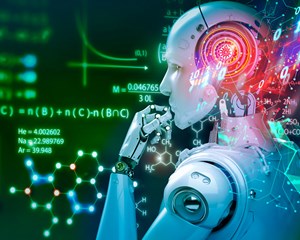Spies and technology
間諜和技術
Machine intelligence
機器智能
Intelligence agencies are grappling with the promise—and pitfalls—of AI
情報機構正在努力應對人工智能帶來的希望和困難
When it comes to using artificial intelligence (AI), intelligence agencies have been at it longer than most. In the coldwarAmerica's National Security Agency (NSA) and Britain's Government Communications Headquarters (GCHQ) explored early AI to help transcribe and translate the enormous volumes of Soviet phone-intercepts they began hoovering up in the 1960s and 1970s.
說到使用人工智能(AI),情報機構比大多數其他機構使用的時間都要長。在冷戰時期,美國國家安全局(NSA)和英國政府通信總部(GCHQ)探索了早期人工智能技術,以幫助轉錄和翻譯他們在20世紀60年代和70年代開始收集的大量蘇聯的竊聽電話。
Yet the technology was immature. One former European intelligence officer says his service did not use automatic transcription or translation in Afghanistan in the 2000s, relying on native speakers instead. Now the spooks are hoping to do better. The trends that have made AI attractive for business in recent years—more data, better algorithms, and more processing power to make it all hum—are giving spy agencies big ideas, too.
然而,這項技術還不成熟。一名前歐洲情報官員表示,本世紀頭十年,他的部門在阿富汗沒有使用自動轉錄或翻譯,而是依賴母語人士。現在,間諜們希望能做得更好。近年來,使人工智能對商業具有吸引力的趨勢——更多的數據、更好的算法和更強大的處理能力,讓一切都變得活躍起來——也給了間諜機構一些大膽的想法。
On February 24th GCHQ published a paper on how AI might change its work. "Machine-assisted fact-checking" could help spot faked images, check disinformation against trusted sources and identify social-media bots that spread it. AI might block cyber-attacks by "analysing patterns of activity on networks and devices", and fight organised crime by spotting suspicious chains of financial transactions.
2月24日,國家通信情報局(GCHQ)發表了一篇關于人工智能可能如何改變其工作的論文。“機器輔助的事實核查”可以幫助識別虛假圖像,檢查不可信來源的虛假信息,并識別傳播這些信息的社交媒體機器人。人工智能可能通過“分析網絡和設備上的活動模式”來阻止網絡攻擊,也可能通過發現可疑的金融交易鏈來打擊有組織犯罪。

Other, less well-resourced organisations have already shown what is possible. The Nuclear Threat Initiative, an American ngo, recently showed that applying machine learning to publicly available trade data could spot previously unknown companies and organisations suspected of involvement in the illicit trade in materials for nuclear weapons. But spy agencies are not restricted to publicly available data.
其他資源不那么豐富的組織已經證明了什么是可能的。美國非政府組織“核威脅倡議”最近表示,將機器學習應用于公開的貿易數據,可以發現以前不為人知的公司和組織,這些公司和組織涉嫌參與用于核武器的材料的非法貿易。但間諜機構并不局限于公開的數據。
Some hope that, aided by their ability to snoop on private information, such modest applications could pave the way to an AI-fuelled juggernaut. "AI will revolutionise the practice of intelligence," gushed a report published on March 1st by America's National Security Commission on Artificial Intelligence, a high-powered study group co-chaired by Eric Schmidt, a former executive chairman of Alphabet, Google's parent company, and Bob Work, a former deputy defence secretary.
一些人希望,在它們窺探私人信息的能力的幫助下,這種不起眼的應用程序可能會為由人工智能驅動的巨大力量鋪平道路。3月1日,美國國家安全委員會發布了一份關于人工智能的報告,報告稱:“人工智能將給情報界帶來一場革命。”美國國家安全委員會是一個強大的研究小組,由谷歌母公司Alphabet前執行董事長埃里克·施密特和前國防部副部長鮑勃·沃克共同擔任其董事長。
The report does not lack ambition. It says that by 2030 America's 17 or so spy agencies ought to have built a "federated architecture of continually learning analytic engines" capable of crunching everything from human intelligence to satellite imagery in order to to foresee looming threats. The commission points approvingly to the Pentagon's response to covid-19, which integrated dozens of data sets to identify covid-19 hotspots and manage demand for supplies.
這份報告并不缺乏雄心壯志。報告稱,到2030年,美國的大概17家間諜機構應該已經建立起了一個“持續學習分析引擎的聯合架構”,能夠分析從人類情報到衛星圖像的一切,以便預測逐漸逼近的威脅。該委員會贊同五角大樓(美國政府)應對新冠的方式,它整合了數十組數據以確定新冠熱點地區和管理供應需求。
譯文由可可原創,僅供學習交流使用,未經許可請勿轉載。











